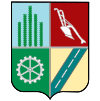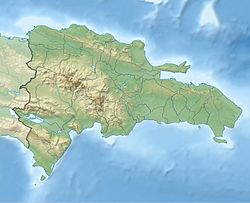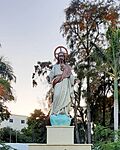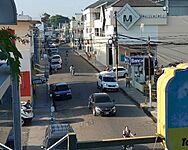Mao, Dominican Republic facts for kids
Quick facts for kids
Santa Cruz de Mao
Mao
|
||
|---|---|---|
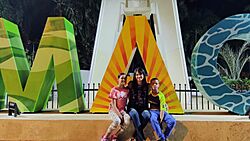
Sign in Mao, Dominican Republic
|
||
|
||
| Country | ||
| Province | Valverde | |
| Founded | 1875 | |
| Municipality since | 1882 | |
| Area | ||
| • Total | 423.60 km2 (163.55 sq mi) | |
| Elevation | 78 m (256 ft) | |
| Population | ||
| • Total | 207,818 | |
| • Density | 490.600/km2 (1,270.647/sq mi) | |
| • Demonym | Maeño(a) | |
| Distance to – Santo Domingo |
210 km |
|
| Municipal Districts | 3 |
|
| Climate | BSh | |
Santa Cruz de Mao, often just called Mao, is a city in the Dominican Republic. It is the main city of the Valverde Province in the northwest part of the country.
Mao is the largest city in the Dominican northwest. It is also the main center for this region. The name "Mao" comes from the Taíno people, who were the first people to live here. It is named after the Mao River, which flows near the city.
The city's special nickname is Ciudad de los Bellos Atardeceres. This means "City of the Beautiful Sunsets" in English. A famous Dominican poet, Juan De Jesus Reyes, gave it this name. There are no mountains to the west of Mao. This means you can often see a bright "red" sky when the sun sets. The area is very dry, and dust in the air helps create this beautiful red color.
Contents
History of Mao
For a long time, the region around Mao was called "El Despoblado." This means "the unpopulated area." It was very dry, so farming was difficult, and not many people lived there.
In 1606, the governor of the Spanish colony told everyone living on the northern coast to move inland. Some people then came to live near where Mao is today. They raised cattle on large farms called hatos. This is why many places around Mao have names like Hatico, Hato del Yaque, and Hato Nuevo. These names remind us of the old cattle ranches.
The town of Mao was built close to where the Mao River meets the Yaque del Norte River. The first Catholic church in the town was built in 1869.
Mao became a Puesto Cantonal, which was an old type of local government area. Later, in 1882, Mao was made a full municipality. In 1904, its official name was changed to "Valverde." This was to honor José Desiderio Valverde, who was a former President of the Dominican Republic. However, everyone still knew the city as Mao. So, people started calling it "Valverde (Mao)," and many still do today.
In 1959, the Valverde Province was created. Mao became the main city and the capital of this new province.
City of Santa Cruz de Mao
Climate in Mao
Mao is in a valley that is protected from the wind. Unlike the wet northern coast of the Dominican Republic, Mao has a hot semi-arid climate. This means it's warm all year, but some months get more rain than others.
Mao gets about 699.6 millimeters (27.5 inches) of rain each year. It rains on about 60.8 days. January is the driest month, with only about 21.3 millimeters (0.8 inches) of rain. May is the wettest month, getting about 119.1 millimeters (4.7 inches) of rain. May also has the most rainy days, with about 9.3 days of rain. July has the fewest rainy days, with only 2.5.
On August 31, 1954, Mao recorded a temperature of 43.0°C (109.4°F). This is the highest temperature ever recorded in the Dominican Republic!
| Climate data for Mao, Dominican Republic (1961-1990) | |||||||||||||
|---|---|---|---|---|---|---|---|---|---|---|---|---|---|
| Month | Jan | Feb | Mar | Apr | May | Jun | Jul | Aug | Sep | Oct | Nov | Dec | Year |
| Record high °C (°F) | 36.8 (98.2) |
38.8 (101.8) |
39.8 (103.6) |
38.0 (100.4) |
40.2 (104.4) |
40.4 (104.7) |
39.0 (102.2) |
43.0 (109.4) |
40.0 (104.0) |
39.8 (103.6) |
40.0 (104.0) |
37.6 (99.7) |
40.4 (104.7) |
| Mean daily maximum °C (°F) | 30.2 (86.4) |
30.9 (87.6) |
32.1 (89.8) |
33.0 (91.4) |
33.7 (92.7) |
34.7 (94.5) |
35.1 (95.2) |
35.5 (95.9) |
35.2 (95.4) |
34.1 (93.4) |
31.7 (89.1) |
30.1 (86.2) |
33.0 (91.4) |
| Mean daily minimum °C (°F) | 18.7 (65.7) |
19.1 (66.4) |
19.9 (67.8) |
20.9 (69.6) |
21.9 (71.4) |
22.7 (72.9) |
23.1 (73.6) |
23.0 (73.4) |
22.5 (72.5) |
21.9 (71.4) |
20.7 (69.3) |
19.2 (66.6) |
21.1 (70.0) |
| Record low °C (°F) | 13.2 (55.8) |
12.2 (54.0) |
14.0 (57.2) |
13.6 (56.5) |
17.0 (62.6) |
19.0 (66.2) |
19.0 (66.2) |
19.0 (66.2) |
18.8 (65.8) |
18.0 (64.4) |
14.8 (58.6) |
12.6 (54.7) |
12.2 (54.0) |
| Average rainfall mm (inches) | 21.6 (0.85) |
34.4 (1.35) |
38.5 (1.52) |
71.4 (2.81) |
119.1 (4.69) |
72.0 (2.83) |
27.3 (1.07) |
42.9 (1.69) |
75.3 (2.96) |
81.9 (3.22) |
74.9 (2.95) |
40.3 (1.59) |
699.6 (27.53) |
| Average rainy days (≥ 1.0 mm) | 3.0 | 3.3 | 3.3 | 5.6 | 9.3 | 6.0 | 2.5 | 4.1 | 6.0 | 7.1 | 6.3 | 4.3 | 60.8 |
| Source: NOAA | |||||||||||||
Economy of Mao
The main way people make a living in this province is through agriculture. The most important crops grown in Mao are rice, bananas, and plantains.
Famous People from Mao
- Monica Boyar (1920–2013) – An American singer who was born in the Dominican Republic.
- Pedro Borbón (1946-2012) – A professional baseball pitcher.
- Félix Fermín (born 1963) – A former professional baseball shortstop and a manager in the Dominican Professional Baseball League.
- Omar Minaya (born 1958) – A baseball executive for MLB teams.
See also
 In Spanish: Mao (República Dominicana) para niños
In Spanish: Mao (República Dominicana) para niños


